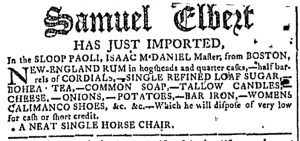This project really helped me expand my knowledge about American life during the Revolutionary period and how important print culture really was. I came into this class thinking it was going to be just like some other history classes I have taken, a class with lectures the most of the time and writing down everything the professor said and then repeating it all back on either an exam or an essay. However, this course is obviously not like those classes and that made me a little skeptical at first. I didn’t know what to expect of the Adverts 250 Project and the Slavery Adverts 250 Project. I wasn’t a fan of them when I first started working on them. However, as I got deeper and deeper into the projects, I started to come across things that I never thought I’d learn and realized that this project was teaching me things about Revolutionary America that I had never thought were important before. For example, when we started talking about newspapers and the role they played during this time, I rolled my eyes because I thought it would be boring and unhelpful. Learning about how newspapers, and especially advertisements, helped with the exchange and passing along of information was actually interesting and gave me a newfound respect for print culture altogether.
This project is very unique and challenged me in ways that I had never been challenged before. It wasn’t a project that I could do in just one night. It’s a project that I had to start early and continuously work on as the weeks progressed. I had to actually think about what I wanted to include and I got to pick what I wanted to write about, which I thought was cool because I rarely get to pick my own topic for an assignment. Reading all of the advertisements and seeing how different they were from advertisements in newspapers today was really cool. Once I chose my advertisements and started to write about them for the project, that was when I was really challenged. Every advertisement is different, so I had to find something intriguing about every advertisement and write about it. I felt pressure because I knew that this would be published and a lot of people were going to see it so I felt that I needed to pay attention to every detail and make sure that it was as well put together as possible. After I was done with all of my advertisements for the week, I felt a sense of accomplishment because I knew my work was going to be published. It was cool to see my work published online for a project of this magnitude and also to see people’s reaction to the work I had done. I have never done anything like this before and it was gratifying to see how many people across the world look at this project and see the effort that I have put into my work. When I look back on the project now, it was not as hard as I thought it was going to be, but it still challenged me and made me step outside my comfort zone. I am happy that I got to do this project because of the sense of accomplishment that it brought me and because of the lessons that I have learned while working on it.







